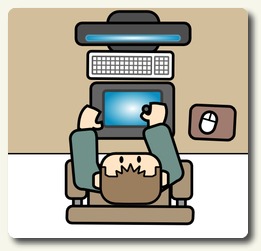-
AuthorPosts
-
September 17, 2018 12:15am #2883Proko is a great suggestion! I would also highly reccomend the books "Figure Drawing: design and invention" by Micheal Hampton, as well as "Drawing the head and hands" by Andrew Loomis. Both are quite easy to find if you google them :)September 13, 2018 11:13pm #2848What I mean is, set it up like the image below where your tablet is flat on the table, parallel to the monitor. Don't turn or tilt the tablet to get stronger marks, turn your canvas instead. I use a very small keyboard so I can overlap it on the top (non active area) of the tablet. Lining your tablet up with your monitor should help you get the hang of the hand-eye disconnect.
As for your second question. Personally, I would stick to practicing by drawing, but ultimately you have to do what is fun for you, otherwise you might burn yourself out. I hear of artists and designers all the time who do away with having a mouse at their computer entirely and only use the pen. Whatever you decide to do to practice just make sure that it's FUN!

credit: https://www.davidrevoy.com/article30/ergonomic-of-graphics-tabletsSeptember 13, 2018 9:58am #2834Allow yourself time to get used to it! Get busy, make messes - the more you play the quicker you'll get it.
The best possible advice I can give you for getting through the tablet-monitor drawing disconnect is to carefully position your tablet to be parallel with your monitor, do not have it off to the side or at an angle. Make sure it is directly in front of your monitor and straight, this will help your hand do what your eye is telling it to without the cursor going all wonky.
Also, If you're drawing and you reach a point where you would usually rotate your sketchbook to get a better stroke, instead of turning the tablet, look for an option in your software to rotate the canvas.
Cheers! <3 -
AuthorPosts






